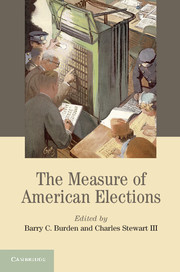Book contents
- Frontmatter
- Contents
- List of figures
- List of tables
- List of contributors
- Acknowledgments
- 1 Introduction to the Measure of American Elections
- 2 Registration and Voting: A View from the Top
- 3 Voter Registration: The Process and Quality of Lists
- 4 Provisional Ballots
- 5 Mail Ballots in the United States: Policy Choice and Administrative Challenges
- 6 Voting from Abroad: Evaluating UOCAVA Voting
- 7 Polling Place Practices and the Voting Experience
- 8 Disability and Election Policies and Practices
- 9 The Performance of Election Machines and the Decline of Residual Votes in the United States
- 10 Voter Confidence as a Metric of Election Performance
- 11 Election Data Transparency
- Appendix
- References
- Index
7 - Polling Place Practices and the Voting Experience
Published online by Cambridge University Press: 05 August 2014
- Frontmatter
- Contents
- List of figures
- List of tables
- List of contributors
- Acknowledgments
- 1 Introduction to the Measure of American Elections
- 2 Registration and Voting: A View from the Top
- 3 Voter Registration: The Process and Quality of Lists
- 4 Provisional Ballots
- 5 Mail Ballots in the United States: Policy Choice and Administrative Challenges
- 6 Voting from Abroad: Evaluating UOCAVA Voting
- 7 Polling Place Practices and the Voting Experience
- 8 Disability and Election Policies and Practices
- 9 The Performance of Election Machines and the Decline of Residual Votes in the United States
- 10 Voter Confidence as a Metric of Election Performance
- 11 Election Data Transparency
- Appendix
- References
- Index
Summary
Americans are changing in terms of when and where they vote. We endeavor to find out whether these changes have affected the voting experience. Americans offer myriad reasons for not voting (Current Population Survey [CPS] 2004, 2006, 2008, 2010). Most of these excuses are beyond immediate remedy. There may be one exception: the way we conduct and administer our elections. Voting place practices have undergone considerable change in the last decade and may offer the most immediate if not direct means of enhancing the voters’ experience at their polling places and possibly voter participation. In this chapter, we ask whether contemporary polling place practices are related to the experiences voters have when voting and whether these practices directly or through voter experiences and other covariates have a nontrivial and appreciable effect on the likelihood of voting.
Our thesis is that when and where voters cast their ballot significantly impact the voter’s experience and the likelihood an eligible voter will actually vote. We find that when voters have a choice of where and when to vote rather than being limited to voting on one day and at a location most proximate to their residence, they are more likely to report a positive voting experience and are more likely to vote. Specifically we find that voters who cast a ballot before Election Day report a more positive voting experience than Election Day voters. Further we find that voters report more favorable voting experiences when they vote in larger voting places – voting places that are more centrally located, where voters work, shop, recreate, and travel, and that have accessible parking, a large number of voting stations, and a large number of poll workers.
- Type
- Chapter
- Information
- The Measure of American Elections , pp. 166 - 187Publisher: Cambridge University PressPrint publication year: 2014
- 10
- Cited by

